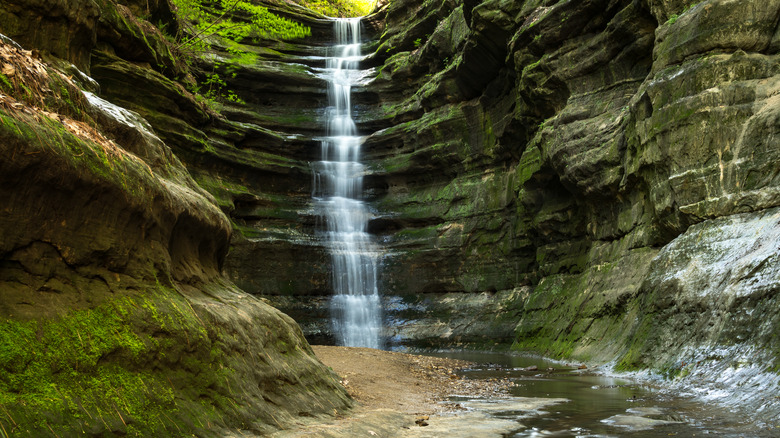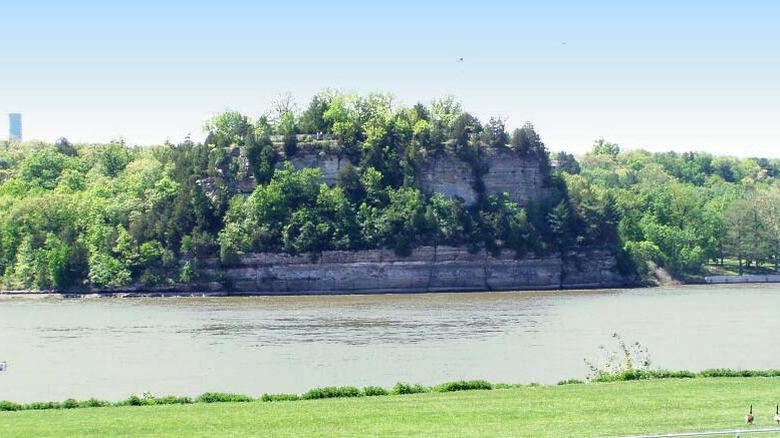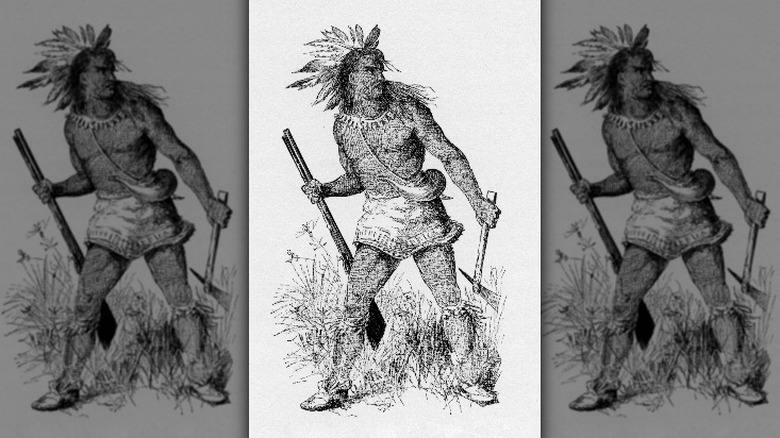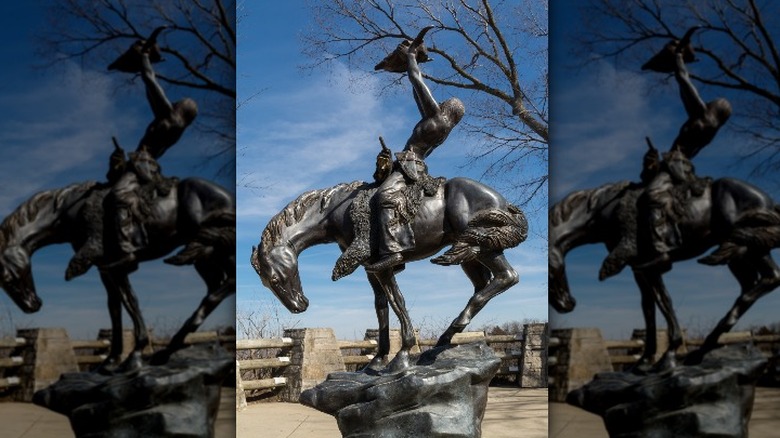The Legend Of Starved Rock Explained
Starved Rock, situated along the south bank of the Illinois River in Deer Park Township, Illinois, is not only a scenic tourist destination — it's also the subject of a violent and dark legend that dates back to the mid 1700s. Although much of Starved Rock's history is documented and verifiable, it is unclear whether the legend, which gave the rock its name, was actually based in fact.
As reported by the College of DuPage, Starved Rock was formed between 15,000 and 17,000 years ago, amid the melting of the Wisconsinan glaciations. The ensuing flood, which geologists named the "Kankakee Torrent," left behind a number of prominent and unique formations, including what would later become known as Starved Rock.
With a summit of approximately 250 feet, the elevated cliff is composed of several layers of white sandstone. Although much of the surface is exposed rock, some portions are covered in enough soil to support the growth of trees and other plant life.
College of DuPage reports Starved Rock is currently part of the historical Starved Rock State Park. However, archaeologists believe the rock, and surrounding area, may have been inhabited by humans as far back as 8000 B.C. By the 1500s, the region was populated by the Illinois tribe. The Illinois Department of Natural Resources reports between 1500 and the 1700s, as many as 10,000 members of the Illinois tribe, divided into several sub-tribes including the Kaskaskia, lived in the region around the majestic rock.
The legend of Starved Rock
In 1693, European explorers discovered the rock, which they named Le Rocher, or "The Rock." As reported by American Indians of Illinois, the explorers, who would eventually establish a mission and construct a fort on Le Rocher, were welcomed by the Kaskaskias. In addition to providing trade opportunities, the explorers vowed to help protect the Illinois tribe from the Iroquois, who had become increasingly aggressive.
American Indians of Illinois reports there are several versions of the legend of Starved Rock. However, in most versions, a member of an Illinois sub-tribe attacked and killed Chief Pontiac of the Ottawa tribe sometime in the mid to late 1700s. In retaliation, the Ottawa were joined by the Mesquakie in an aggressive strike against the Illinois.
Unable to fend off their attackers, the Illinois reportedly fled to the top of Le Rocher, which had been abandoned by the explorers, to seek refuge. As reported by the Illinois Department of Natural Resources, the fighting continued until "the cliffs of the rock were stained red and slippery with the remains."
Although the rock provided the Illinois with shelter and safety, there were few resources. In addition to a lack of food, the nearest source of water was more than 100 feet below, at the base of the rock –- and in clear sight of their enemies. According to legend, those who survived the attack ultimately starved to death, as they had no access to resources. The rock subsequently became known as Starved Rock.
What actually happened at Starved Rock?
As reported by Mark Walczynski, in his article, "The Starved Rock Massacre of 1769: Fact or Fiction," the legend of Starved Rock was widely believed and accepted by Native American tribes in and around the region. However, there are no written records proving Pontiac's death was associated with any kind of uprising, and some sources suggest the battle was actually related to a dispute over hunting grounds.
According to Walczynski, there is also no known written evidence of a massacre at Starved Rock. However, research suggests the legend was passed down by Potawatomi Chief Meachelle and Ottawa Chief Shick-Shack, who both reportedly witnessed the attack.
In the late 1800s, Chief Meachelle told Judge John Dean Caton he was a young boy when the Starved Rock massacre occurred. However, the incident made a strong impression on him and remained clear in his mind. According to his account, the Illinois fled to Le Rocher for refuge amid growing tensions with the other tribes. With few resources, they were eventually weakened by hunger and thirst. As they descended to the base of the rock, they were attacked and ultimately killed by Pontiac's allies.
Walczynski reports Chief Shick-Shack told his account of the massacre to historian and state representative Perry Armstrong around the same time Meachelle spoke with Judge Caton. According to Shick-Shack, disputes over hunting grounds had escalated and ultimately led to a violent battle between the Illinois and the Kickapoo, Miami, and Potawatomi tribes.
There is no proof anyone ever starved on Starved Rock
As reported by Walczynski, Chief Shick-Shack said the Illinois were overcome by the other tribes and fled to the summit of the Le Rocher. In addition to being weakened by thirst and hunger, the Illinois were struck by a smallpox outbreak. Like Meachelle, Shick-Shack also remembered the Illinois being massacred as they descended Le Rocher in desperation.
Although Meachelle and Shick-Shack's stories were compelling, and quite similar, neither accounted for the legends that suggest the Illinois starved to death on the summit of Le Rocher. As reported by the Daily Journal, Walczynski eventually concluded the Illinois Tribe had left the region and relocated to southern Illinois by 1769, when the massacre reportedly occurred. In his opinion, the legend actually originated with an earlier battle in 1722.
During the 1722 battle, a sub-tribe of the Illinois, called the Peoria, fought with the Fox tribe in the area surrounding Le Rocher. During that battle, some of the natives were briefly trapped on the summit of Le Rocher. However, there is no indication that anyone starved there.
As reported by the Daily Journal, Walczynski said his intention was not "debunking the Starved Rock legend." In fact, the rock, and the surrounding park continue to draw tourists despite the questionable origin of the legend. In addition to the majestic rock, the park offers opportunities for fishing, hiking, and other outdoor recreation, and remains one of Illinois' most popular parks.



